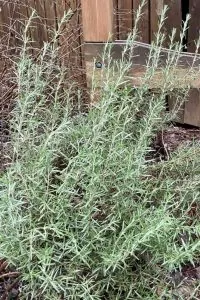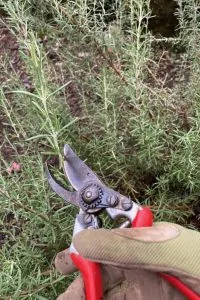Looking for the best rosemary companion plants? You’re in the right place. Learn what you can plant next to rosemary and what you should not plant near rosemary. Get ideas about which vegetables grow well with rosemary, which flowers grow well with rosemary, which herbs grow well with rosemary, and which fruit grows well with rosemary. It’s all here, along with tips for planting and growing rosemary. Whether you live in the United States, the UK, or anywhere else, you can find out about the best place to plant rosemary, the best fertilizer for rosemary, and whether rosemary needs a lot of water. I’ve been growing and harvesting rosemary for over 25 years, using it in recipes year-round. If you are looking for a low-maintenance, edible, deer-resistant addition to your plant collection, read on to learn how simple it is to grow rosemary in your garden. Get a handy chart listing companion plants for rosemary as well.
Table of Contents
My History with Growing Rosemary
I was given my first rosemary plant about 26 years ago. I was changing jobs and a colleague gave me a rosemary plant in a container. It was trimmed to look like a little Christmas tree. Unfortunately, I did not know how to take care of it. I watered it too much, didn’t ensure that it had enough drainage in it’s container, and it died. I was hooked though, so I went out and purchased some rosemary to plant in our yard.
Ways to Use Rosemary
Over the years, I have used the rosemary in a variety of ways in the kitchen. Some of my favorite recipes that use rosemary are rosemary roasted potatoes and lemon rosemary roasted chicken. I’ve also used woody rosemary stems as skewers when grilling vegetables and meat. Not only is rosemary attractive, with its delicate blue blooms and evergreen leaves, but it’s also a deer-resistant herb. That makes it a huge winner in my book! What can you plant with rosemary? Let’s find out!
Where is the Best Place to Plant Rosemary?
When companion planting rosemary, choose a location that receives full sun for most of the day. Rosemary can tolerate partial shade, but it grows best and is most fragrant in full sun. The plant also needs well-draining, sandy soil with a pH between 6.0 and 7.0. If your soil is heavy or clay-like, you may need to mix in some compost or well-rotted manure to improve the drainage.
It is also a good idea to plant rosemary in a location that is protected from strong winds, which can dry out the plant and damage the leaves. If you live in a cold climate, choose a sunny, sheltered spot or grow rosemary in a container that can be brought indoors during the winter. We have our rosemary planted in two locations. One plant is located in a sheltered spot near the south side of the house. The other plant is located on the south side of a rock retaining wall. Both plants receive full sun exposure.

Which Flowers Grow Well with Rosemary?
Rosemary can be paired with a range of flowers to create a beautiful and fragrant display. Some flowers that grow well with rosemary when companion planting include:
Calendula: Calendula, also known as pot marigold, is a hardy annual flower that produces bright, sunny blooms in shades of orange, yellow, and gold. It is easy to grow and thrives in a range of soil types, making it a good companion for rosemary.
Cosmos: Cosmos are annual flowers that are easy to grow and produce a profusion of colorful blooms in shades of pink, red, orange, yellow, and white. They thrive in sunny, well-draining soil and are generally resistant to pests and diseases. Cosmos and rosemary can be planted together in the same bed or garden, as they have similar growing requirements and can complement each other well.
Lavender: Lavender is a popular companion plant for rosemary, as both herbs are native to the Mediterranean and have similar growing requirements. The two plants also complement each other well in the garden, with the purple flowers of lavender and the pale blue flowers of rosemary creating a stunning color contrast.
Marigold: Marigolds are annual flowers that come in a range of bright, cheerful colors and are easy to grow. They are known for their ability to deter pests and can help protect rosemary from aphids and other common garden pests.
Nasturtium: Nasturtiums are known for their ability to deter pests, and their bright, cheerful flowers can add a splash of color to the garden. They have similar growing requirements as rosemary, so would be good companion flowers for rosemary plants.
Zinnia: Zinnias are annual flowers that produce a profusion of colorful blooms in shades of pink, red, orange, yellow, and white. They are easy to grow and thrive in sunny, well-draining soil, making them a good choice for planting with rosemary.
There are some other flowers that make good companion plants for rosemary because of their ability to attract pollinators. These plants include black-eyed Susan, coneflowers, daisies, and sunflowers.
Which Fruits Grow Well with Rosemary?
Rosemary can be paired with a range of fruits to create a beautiful and flavorful display. The deer-resistant properties of rosemary make it an ideal companion for anything you want to deter deer from eating. Some fruits that grow well with rosemary include:
Strawberry: Strawberry plants produce sweet, juicy fruits that are a favorite with gardeners and can be grown in a range of climates. They thrive in well-draining soil and prefer a sunny location. Planting strawberries near rosemary can help to deter pests and improve the flavor of the fruit. When planting rosemary near strawberries, be sure to give each plant enough space to grow and thrive. Rosemary and strawberry companion plants are a winning combination.
Raspberry: Raspberries are a popular fruit that produces sweet, juicy berries that are high in antioxidants and other nutrients. They grow best in well-draining soil and prefer a sunny location. Rosemary can help to deter pests and improve the flavor of the fruit when grown nearby.
Blueberry: Blueberries are a tasty and nutritious fruit that is high in antioxidants and other nutrients. They grow best in well-draining, acidic soil and prefer a sunny location. Planting rosemary near blueberry bushes can help to deter pests and improve the flavor of the fruit.
Cherry: Cherry trees produce sweet, juicy fruits that are a favorite with gardeners and are high in antioxidants and other nutrients. They grow best in well-draining soil and prefer a sunny location. Planting rosemary near cherry trees can help to deter pests and improve the flavor of the fruit.
Apple: Apple trees produce sweet, juicy fruits that are a favorite with gardeners and are high in antioxidants and other nutrients. They grow best in well-draining soil and prefer a sunny location. Planting rosemary near apple trees can help to deter pests and improve the flavor of the fruit.
We have blueberries, strawberries, and raspberries all planted on the east side of our vegetable garden. The strawberries and raspberries are especially susceptible to deer damage. A whole hedge of rosemary planted on the eastern edge of our garden would be a good idea!
Which Herbs Grow Well with Rosemary?
Rosemary can be paired with a range of herbs to create a beautiful and fragrant display. Some herbs that grow well with rosemary include:
Basil: Basil is a tender annual herb that is well-suited to sunny, well-draining soil. It produces small, white or purple flowers and has a strong, pungent aroma that is often used in cooking.
Borage: Borage is an annual herb that produces bright blue flowers and hairy leaves. It is a good choice for planting with rosemary, as it is drought-tolerant and attracts pollinators to the garden.
Chives: Chives are a hardy herb that is easy to grow and is well-suited to a wide range of climates. They produce small, purple flowers and have a mild, onion-like flavor. The soil and water requirements for chives are similar to that of rosemary, so the plants may be planted in the same bed.
Marjoram: Marjoram is a hardy herb that produces small, white or pink flowers and has a sweet, aromatic flavor that is often used in cooking. It can complement rosemary as it had similar growing requirements. Marjoram is generally easier to grow than rosemary, as it is less prone to pests and diseases and does not require as much care and attention.
Mint: Mint is a hardy herb that is well-suited to sunny, well-draining soil. It produces small, purple or pink flowers and has a strong, refreshing aroma that is often used in cooking and aromatherapy.
Oregano: Oregano is a hardy herb that is well-suited to sunny, well-draining soil. It produces small, white or pink flowers and has a strong aroma that is often used in cooking.
Parsley: Parsley is a hardy herb that produces small, green flowers and has a mild, slightly bitter flavor. It is often used as a garnish as well as for flavor.
Sage: Sage is a hardy herb that is well-suited to sunny, well-draining soil. It produces violet-blue flowers and has a pungent aroma.
Thyme: Like rosemary, thyme is a hardy herb that is well-suited to sunny, well-draining soil. It produces small, pink or purple flowers that look beautiful planted alongside rosemary.
Which Vegetables Grow Well with Rosemary?
There are many rosemary companion vegetables. I’m glad that rosemary can be grown alongside a variety of vegetables in the garden because I switch around my vegetable garden planting arrangement each year. Some vegetables that grow well with rosemary include bell peppers, carrots, eggplant, garlic, green beans, onions, potatoes, tomatoes, and zucchini. Rosemary can also be grown with legumes such as beans and peas. If your vegetable garden gets rototilled every year like mine does, you would want to plant the rosemary in a place that does not get tilled, of course. Perhaps consider planting rosemary along the vegetable garden border.
What Should You Not Plant Near Rosemary?
Now that we have discussed what grows well with rosemary, it’s time to learn what not to plant with rosemary. There are a few plants that are considered bad companion plants for rosemary. It is generally recommended to avoid planting rosemary near vegetables that are prone to fungal diseases. Some vegetables that should not be planted near rosemary include broccoli, Brussels sprouts, cabbage, and cauliflower. Fennel has been known to inhibit the growth of rosemary, so it does not make a good rosemary companion plant either.
Quick Rosemary Companion Plant Reference Chart
| Rosemary Companion Plants: Flowers | Rosemary Companion Plants: Fruit | Rosemary Companion Plants: Herbs | Rosemary Companion Plants: Vegetables | Worst Rosemary Companion Plants |
| Black-eyed Susan | Apples | Basil | Bell Pepper | Broccoli |
| Calendula | Blueberries | Chives | Beans | Brussels sprouts |
| Coneflower | Cherries | Marjoram | Carrots | Cabbage |
| Cosmos | Raspberries | Mint | Eggplant | Cauliflower |
| Daisies | Strawberries | Oregano | Garlic | Fennel |
| Lavender | Parsley | Green Beans | ||
| Marigold | Sage | Mushrooms | ||
| Nasturtiums | Thyme | Onions | ||
| Sunflowers | Peas | |||
| Zinnia | Potatoes | |||
| Tomatoes | ||||
| Zucchini |
How Many Rosemary Plants Do You Need?
The number of rosemary plants you need for your home garden will depend on a variety of factors, including the size of your garden, your personal preferences, and how you plan to use the rosemary. Here are a few things to consider when determining how many rosemary plants you need:
Space: Rosemary plants can grow to be quite large, so be sure to give them enough space to spread out. A single rosemary plant can reach a height of up to 4 feet and a width of up to 3 feet, so plan accordingly.
Use: If you plan to use rosemary frequently in your cooking, you may want to plant more than one rosemary plant to ensure that you have a steady supply of fresh herbs. On the other hand, if you only plan to use rosemary occasionally, one plant may be sufficient.
Personal preferences: Some people like to have a variety of herbs in their garden, while others prefer to focus on a few specific herbs. Consider your personal preferences when determining how many rosemary plants to include in your garden.
Overall, it is a good idea to start with one or two rosemary plants and see how they do in your garden. You can always add more plants later if you find that you need them. We have two, and that has always been plenty for our culinary needs. Need four rosemary plants? Here’s a 4-pack of potted rosemary plants so you can get started with your rosemary companion planting right away.
Can Rosemary be Divided?
Yes, rosemary plants can be divided to create new plants. Dividing rosemary plants is a good way to propagate the plant and create new plants for your garden or for gifts. If you would like to create a deer-resistant rosemary hedge, dividing the rosemary you already have would be a good start.
To divide a rosemary plant, follow these steps:
Choose a healthy rosemary plant that has well-established roots.
Water the plant well a day or two before dividing it to make the roots more pliable.
Carefully dig up the plant, taking care not to damage the roots.
Use a sharp knife or Felco pruning shears to carefully divide the plant into smaller sections. Each section should have a good root system and at least one stem.
Plant the divided sections in well-drained soil, making sure to space them out enough to give them room to grow.
Water the plants well and keep them moist until they are well-established.
It is generally best to divide rosemary plants in the spring or early summer when the weather is warm and the plants are actively growing. With proper care, the divided rosemary plants should thrive and grow into healthy, productive plants.

Does Rosemary Transplant Well?
Rosemary plants can be successfully transplanted, but they do have specific requirements that must be met in order for the transplant to be successful. Here are a few things to consider when transplanting rosemary:
Timing: It is generally best to transplant rosemary plants in the spring or early summer when the weather is warm and the plants are actively growing. Avoid transplanting rosemary during periods of extreme heat or cold, as the plants may not survive the stress of the move.
Soil: Rosemary plants prefer well-drained soil that is rich in organic matter. When transplanting, be sure to choose a location with soil that meets these requirements.
Sunlight: Rosemary plants need plenty of sunlight to thrive, so be sure to choose a location that gets at least 6 hours of direct sunlight per day.
Water: Water the transplanted rosemary plants well after transplanting to help them settle in and become established. Avoid letting the soil dry out completely, but do not overwater, as rosemary plants do not tolerate wet or soggy conditions.
With proper care, rosemary plants should transplant well and continue to grow and thrive in their new location.
What is the Best Fertilizer for Rosemary?
Rosemary plants are generally easy to care for and do not require a lot of fertilization. However, if you want to give your rosemary plants a boost, there are a few types of fertilizers that can be effective. Here are a few options to consider:
Compost: Compost is an excellent natural fertilizer for rosemary plants. It helps to improve the soil structure and fertility, and it provides a slow-release source of nutrients that the plants can use over time.
Organic fertilizers: There are many types of organic fertilizers that can be used to nourish rosemary plants. Some options include bone meal, fish emulsion, and kelp meal.
Synthetic fertilizers: Synthetic fertilizers can also be used to fertilize rosemary plants. Look for a balanced fertilizers with a ratio of around 20-20-20, or choose a fertilizer that is specifically formulated for herbs.
It is generally best to fertilize rosemary plants lightly and on a regular basis, rather than applying a large amount of fertilizer all at once. This will help prevent overfertilization, which can lead to leaf burn and other problems.
How Much Water Does Rosemary Need?
Rosemary plants are fairly drought-resistant and do not require a lot of water to thrive. In fact, it is important to avoid overwatering rosemary, as the plants can suffer from root rot if the soil is consistently moist or soggy.
To water rosemary plants, it is generally best to water them deeply and infrequently. This means letting the soil dry out slightly between waterings, and then watering the plants thoroughly to ensure that the water reaches the roots. Avoid watering the foliage of the plants, as this can lead to fungal diseases.
In general, rosemary plants should be watered when the top inch or two of soil feels dry. This will vary depending on the climate, soil type, and other factors, so you may need to adjust your watering schedule accordingly.
If you are uncertain whether or not your rosemary plants need water, you can check the moisture level of the soil by sticking your finger about an inch into the soil. If the soil feels dry at this depth, it is time to water the plants.
How Do You Winterize Rosemary?
If you live in an area with very cold winters, you may need to take some steps to winterize your rosemary plants to ensure their survival. Here are a few tips for winterizing rosemary:
Mulch: Mulching rosemary plants with a layer of straw, leaves, or other organic material can help protect the roots and lower parts of the plants from extreme cold.
Water: Be sure to water your rosemary plants well before the first hard frost of the season. This will help the plants to store moisture and survive dry spells during the winter.
Protect from wind: Wind can be especially damaging to rosemary plants during the winter, as it can dry out the foliage and cause the plants to lose moisture. To protect your rosemary plants from wind, consider planting them in a sheltered location or using a windbreak such as a fence or wall.
Prune: Pruning your rosemary plants in the fall can help to remove any damaged or diseased branches, which can help the plants to survive the winter in better condition.
By following these tips, you can help your rosemary plants to survive the winter and emerge healthy and vigorous in the spring.
Popular Varieties of Rosemary
There are many different varieties of rosemary to choose from, each with its own unique characteristics. Here are a few popular varieties that you may want to consider:
‘Arp’: ‘Arp’ is a hardy, upright variety of rosemary that is known for its strong, pungent flavor and aroma. It is a good choice for use in cooking, and it is resistant to many of the pests and diseases that can affect rosemary plants.
‘Tuscan Blue’: ‘Tuscan Blue’ is a popular variety of rosemary with a trailing habit and bright blue flowers. It is a good choice for planting in containers or hanging baskets, and it is known for its robust flavor and aroma.
‘Miss Jessopp’s Upright’: ‘Miss Jessopp’s Upright’ is a variety of rosemary with an upright growth habit and dark green leaves. It is a good choice for use in cooking, and it is known for its strong, pungent flavor and aroma.
‘Prostratus’: ‘Prostratus’ is a trailing variety of rosemary with a creeping habit and delicate blue flowers. It is a good choice for planting in containers or hanging baskets, and it is known for its mild flavor and aroma.
When choosing a variety of rosemary, consider your personal preferences and the specific needs of your garden. With so many varieties to choose from, you are sure to find one that is perfect for your needs.
Growing Rosemary in a Container
Rosemary is well-suited for container gardening because it has a compact growth habit and does not require a lot of space. In fact, rosemary can be an ideal plant for container gardening because it is drought-tolerant and does not require a lot of water.
To grow rosemary in a container, choose a pot that is at least 12 inches in diameter and has good drainage (so yours doesn’t die like my first rosemary plant did). Fill the pot with a well-draining soil mix, and plant the rosemary so that the top of the root ball is level with the soil surface. Water the plant thoroughly after planting, and then allow the soil to dry out slightly before watering again.
Rosemary prefers a sunny location, so choose a spot that receives at least 6 hours of direct sunlight per day. It is also a good idea to fertilize the plant every few weeks with a balanced fertilizer to promote healthy growth. With proper care, your rosemary plant should thrive in a container.
How do you choose what to plant with rosemary in a container? Some of the companion plants that have already been listed would be ideal container companion plants for rosemary as well. Do you subscribe to the container formula of “thriller, filler, spiller” as described in this post about simple ideas for planting garden containers? If so, chives would be an excellent filler, and you could use creeping thyme or mint as a spiller planted at the edge of the container.
Cooking with Rosemary
Now that you know what to plant with rosemary, you might want some easy recipes that make use of your rosemary crop. Rosemary is the ideal seasoning for many dishes. It goes well with garlic in this lemon garlic roasted chicken recipe. Other delicious rosemary garlic combinations include roasted red skin rosemary garlic potatoes and an easy one-skillet rosemary, potato, tomato, and sausage meal. There are many delightful ways to use rosemary in recipes.
Other Deer-Resistant Plants
One of rosemary’s best qualities is that it is deer resistant. If you are seeking more deer-resistant plants like rosemary, check out my list of the best deer-resistant vegetables, flowers, and herbs. Avoid the disappointment of seeing your garden chewed to bits by planting things that deer avoid.
Need More Planting Ideas?
Check out the tips for the best companion plants for eggplant to learn what to grow with those beauties. If you like the idea of companion planting, you might be interested in reading about the best companion plants for pumpkins, sunflowers, garlic, asparagus, or the best companion plants for lavender. Get tips for growing stunning dahlias. Are you a beginning gardener? Try planting some foolproof, easy-care perennials, or learning about the best companion plants for columbine. There are so many exciting plants to grow!
Keep Track of Your Garden with a Journal Logbook
Now that you have learned about some compatible companion plants, keep track of your planting ideas, goals, and plans with a free garden journal logbook. Choose the pages you want to print and customize them as you wish to record monthly, weekly, and daily garden tasks, lists, weather, and planting arrangements. There are also grid pages for easily designing the layout of your vegetable garden, flower garden, or landscape. Print it out and put it into a notebook you can take with you to the garden (that’s what I do). It’s nice to have all of your garden information in one place.
Free Online Garden Planner Layout Template
Now that you know which are the best companion plants for rosemary, you might need a way to plan your garden layout. Whether you are planting vegetables, flowers, or herbs near your rosemary plant, this online garden planner can help you visualize your design and bring it to life. With garden tasks that need your attention, this is one way to save time.
It’s fully customizable when you make your own copy and includes two editable chart pages for noting planting specifications.
Get my free online garden layout planner template!
Organize Your Garden Tasks with a Free Garden Planner Notebook
As a result of needing to keep track of garden tasks throughout the year, I decided to begin a garden planner notebook. It has a page for each month, along with notes pages. If a garden planner notebook seems like a good idea to you, good news! You can get it here!
Get the garden notebook!
Have a wonderful week, and may all of your rosemary-growing endeavors meet with success!

Lisa Mitchell is a wife, mom, and school librarian who likes to grow fruit, herbs, vegetables, and flowers on her family’s small Pacific Northwest farm. To learn more about what this website has to offer gardeners, click on over to the Garden page.
Like what you read here? Please give it a share!
Want more great garden, food, or travel ideas? Follow FluxingWell on Pinterest, Facebook, Instagram, and X for the latest posts, tips, and inspiration.






This is such good info. It’s always hard to know what herbs grow well together because I know some don’t at all!
I’m glad you like the rosemary companion plant tips.
It’s very good to know that rosemary is deer-resistant as we get so many deer in our neighborhood and they eat everything!!! People think that as an interior designer that designing a garden would be easy for me, but I feel so lost. I appreciate knowing what companion plants are good with rosemary, and I appreciate the free garden planner. I am downloading it, but I have no idea where to begin!!! Can I hire you? 😀
Haha…you would probably end up with everything planted in straight rows! That’s why I do the vegetable garden each year. I’m getting better at arranging companion plants in the perennial and herb garden, but I have to be super careful not to let things get too symmetrical. I guess that’s the librarian in me!
Great and informative post on the best rosemary companion plants. I’ve wanted to plant more in my backyard, but the deer are always in my yard. Very interesting this is deer resistant. Thank you for the suggestion and great information.
Yes, rosemary is deer resistant! If you plant more in your backyard, I’d be curious to know if the deer leave it alone.
Thank you for listing the best rosemary companion plants. We are going to have to transplant our rosemary soon. Thanks for the ideas about location.
Sure thing! Good luck with the transplanting process. I’ve transplanted rosemary before, and the plants survived just fine.
That’s a great guide, Lisa! I need to go back to it when we start planning our garden in spring!
Thank you! Good luck with your garden planning.